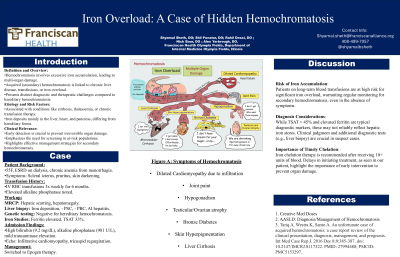Monday Poster Session
Category: Liver
P3057 - Iron Overload: A Case of Hidden Hemochromatosis
Monday, October 28, 2024
10:30 AM - 4:00 PM ET
Location: Exhibit Hall E

Has Audio

Shyamal Sheth, DO
Franciscan Health Olympia Fields
Chicago, IL
Presenting Author(s)
Shyamal Sheth, DO1, Shil Punatar, DO1, Rahil Desai, DO1, Nick Baur, DO2, Alex Yarbrough, DO1
1Franciscan Health Olympia Fields, Chicago, IL; 2Franciscan Health Olympia Fields, Olympia Fields, IL
Introduction: Acquired hemochromatosis, typically causes by chronic iron overload due to red blood cell transfusions, is a significant global health concern. While phlebotomy is the traditional treatment, patients with acquired anemia require chelation therapy to prevent end-organ damage.
Case Description/Methods: We present a case of a 55-year-old female with end-stage renal disease on hemodialysis and iron deficiency anemia due to chronic menorrhagia who presented with scleral icterus, generalized pruritus, and progressive skin darkening. For the prior 6 months, she had been receiving intravenous (IV) RBC transfusions thrice weekly. Subsequently, she developed elevated alkaline phosphatase levels prompting an extensive diagnostic workup. Magnetic Resonance Cholangiopancreatography revealed no evidence of obstruction, but demonstrated hepatic scarring deposition, and hepatomegaly. Liver biopsy confirmed the presence of iron deposition, and excluded primary sclerosing cholangitis, primary biliary cirrhosis, and autoimmune hepatitis. Common hereditary hemochromatosis mutation gene testing, C282Y and H63D, were negative. Despite an elevated ferritin level, the patient's transferrin saturation (TSAT) remained below threshold at 33. Drug-induced liver injury was considered, but discontinuation of the implicated medication failed to alleviate symptoms. On admission, hepatic panel revealed elevated total bilirubin (9.2 mg/dL) and alkaline phosphatase (981 U/L), with mildly elevated transaminases. Echocardiogram was suggestive of infiltrative cardiomyopathy leading to massive tricuspid regurgitation which was managed through diuresis. Patient was recommended to switch from IV iron to Epogen therapy, and discharged with outpatient follow-up, which were not pursued.
Discussion: Patients on long-term blood transfusion therapy are at risk for significant iron accumulation. The American Association for the Study of Liver Diseases advocates for evaluation for hemochromatosis, even in asymptomatic individuals with abnormal iron studies or evidence of liver disease. While, the diagnosis of acquired hemochromatosis typically requires a TSAT > 45% alongside elevated ferritin levels, prior literature has shown these values to not be the most reliable indicator of hepatic iron stores. Chelation is typically initiated prophylactically in patients receiving over 10 units of blood, but was delayed in our patient with acquired hemochromatosis, underscoring the need for physician vigilance and timely intervention in these cases.
Disclosures:
Shyamal Sheth, DO1, Shil Punatar, DO1, Rahil Desai, DO1, Nick Baur, DO2, Alex Yarbrough, DO1. P3057 - Iron Overload: A Case of Hidden Hemochromatosis, ACG 2024 Annual Scientific Meeting Abstracts. Philadelphia, PA: American College of Gastroenterology.
1Franciscan Health Olympia Fields, Chicago, IL; 2Franciscan Health Olympia Fields, Olympia Fields, IL
Introduction: Acquired hemochromatosis, typically causes by chronic iron overload due to red blood cell transfusions, is a significant global health concern. While phlebotomy is the traditional treatment, patients with acquired anemia require chelation therapy to prevent end-organ damage.
Case Description/Methods: We present a case of a 55-year-old female with end-stage renal disease on hemodialysis and iron deficiency anemia due to chronic menorrhagia who presented with scleral icterus, generalized pruritus, and progressive skin darkening. For the prior 6 months, she had been receiving intravenous (IV) RBC transfusions thrice weekly. Subsequently, she developed elevated alkaline phosphatase levels prompting an extensive diagnostic workup. Magnetic Resonance Cholangiopancreatography revealed no evidence of obstruction, but demonstrated hepatic scarring deposition, and hepatomegaly. Liver biopsy confirmed the presence of iron deposition, and excluded primary sclerosing cholangitis, primary biliary cirrhosis, and autoimmune hepatitis. Common hereditary hemochromatosis mutation gene testing, C282Y and H63D, were negative. Despite an elevated ferritin level, the patient's transferrin saturation (TSAT) remained below threshold at 33. Drug-induced liver injury was considered, but discontinuation of the implicated medication failed to alleviate symptoms. On admission, hepatic panel revealed elevated total bilirubin (9.2 mg/dL) and alkaline phosphatase (981 U/L), with mildly elevated transaminases. Echocardiogram was suggestive of infiltrative cardiomyopathy leading to massive tricuspid regurgitation which was managed through diuresis. Patient was recommended to switch from IV iron to Epogen therapy, and discharged with outpatient follow-up, which were not pursued.
Discussion: Patients on long-term blood transfusion therapy are at risk for significant iron accumulation. The American Association for the Study of Liver Diseases advocates for evaluation for hemochromatosis, even in asymptomatic individuals with abnormal iron studies or evidence of liver disease. While, the diagnosis of acquired hemochromatosis typically requires a TSAT > 45% alongside elevated ferritin levels, prior literature has shown these values to not be the most reliable indicator of hepatic iron stores. Chelation is typically initiated prophylactically in patients receiving over 10 units of blood, but was delayed in our patient with acquired hemochromatosis, underscoring the need for physician vigilance and timely intervention in these cases.
Disclosures:
Shyamal Sheth indicated no relevant financial relationships.
Shil Punatar indicated no relevant financial relationships.
Rahil Desai indicated no relevant financial relationships.
Nick Baur indicated no relevant financial relationships.
Alex Yarbrough indicated no relevant financial relationships.
Shyamal Sheth, DO1, Shil Punatar, DO1, Rahil Desai, DO1, Nick Baur, DO2, Alex Yarbrough, DO1. P3057 - Iron Overload: A Case of Hidden Hemochromatosis, ACG 2024 Annual Scientific Meeting Abstracts. Philadelphia, PA: American College of Gastroenterology.
